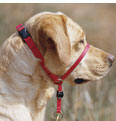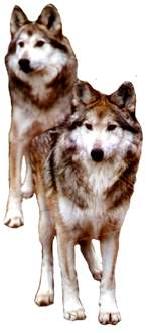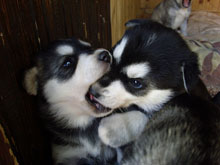 Introduction
Introduction
There are many brands of head collars. One of the
more established and recognized brand is the
Gentle Leader® Headcollar with a nose and neck loop that
gently directs
your dog's nose and entire head (not
just neck).
|
Head collars put gentle pressure
on both the neck and muzzle
spots giving the subliminal
message, "Be calm. I am in
charge." |
 Establishing Positive Leadership
Establishing Positive Leadership
With head
collars, gentle human leadership
is accomplished in the way the
collar places pressure on the
dog's neck and nose. The neck
loop applies pressure on the
back of the neck, working with
your dog's natural relaxation
instinct and producing a calming
effect. This is the spot
originally used by the mother
dog to
pick up her puppies. When the
mother carries the puppies by
the back of the neck, it
triggers an instinctive "go
passive" reflex. Evolutionarily,
this makes it easier for the mom
to carry the pups to a new safe
place. This passivity reflex
decreases with age, but is still
present to some degree in most
adult dogs.
 In addition,
one of the ways the wolf "pack
leader" communicates his or her
position is by gently but firmly
grasping a subordinate's muzzle
in his or her mouth.
Since dogs are evolved from
wolves, this leadership message
seems to have been carried
forward in domestic dogs. The
head collar's nose loop
encircles the dog's muzzle in
the same manner.
In addition,
one of the ways the wolf "pack
leader" communicates his or her
position is by gently but firmly
grasping a subordinate's muzzle
in his or her mouth.
Since dogs are evolved from
wolves, this leadership message
seems to have been carried
forward in domestic dogs. The
head collar's nose loop
encircles the dog's muzzle in
the same manner.
Never jerk or yank the leash!
Try to forget everything you've
ever seen or heard about "choke
chains." A smooth pull on a head
collar is all you need to
communicate positively and
effectively with your dog. The
dog can simply "do the right
thing" and the reward is the
release of pressure.
Praise the behavior you want to
help your dog learn. Leash
walking...read
more on leash training.
Gradually phase out
the food treats and increase the interval between
your praise. Most dogs learn quickly that the head
collar means they get to go for a walk and come to
love their head collar. When walking the dog is more
fun for the person, the dog gets to go on more
frequent walks! Leashes and collars...read
more on collar selection.
|
As long as
the dog is walking with
slack in the lead, reward
the dog with more freedom,
praise and food treats.
|
 Proper
Fit - An Absolute Must!
Proper
Fit - An Absolute Must!
Head collars
help move a dog's body naturally follows without
pain or harm. But, correct fit and use is
crucial to its effectiveness. During this training
time, it can be helpful to have the dog wearing a
head collar and dragging a leash indoors. Do not
grab the dog by the collar. If you want to use a
head collar to help teach a "quiet" instruction, use the
leash-collar combination to gently pull the dog's
mouth closed as you give the quiet instruction. Head
collars...read
more.